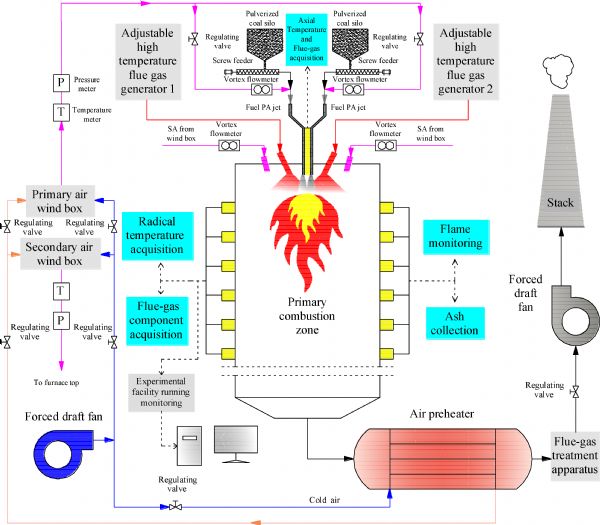

Influence of nozzle height to width ratio on ignition and NOx emission characteristics of semicoke/bituminous coal blends in a 300 kW pulverized coal-fired furnace
Received date: 01 Jun 2020
Accepted date: 31 Aug 2020
Published date: 15 Jun 2021
Copyright
To improve the ignition behavior and to reduce the high NOx emissions of blended pulverized fuels (PF) of semicoke (SC), large-scale experiments were conducted in a 300 kW fired furnace at various nozzle settings, i.e., ratios (denoted by hf/b) of the height of the rectangular burner nozzle to its width of 1.65, 2.32, and 3.22. The combustion tests indicate that the flame stability, ignition performance, and fuel burnout ratio were significantly improved at a nozzle setting of hf/b = 2.32. The smaller hf/b delayed ignition and caused the flame to concentrate excessively on the axis of the furnace, while the larger hf/b easily caused the deflection of the pulverized coal flame, and a high-temperature flame zone emerged close to the furnace wall. NOx emissions at the outlet of the primary zone decreased from 447 to 354 mg/m3 (O2 = 6%), and the ignition distance decreased from 420 to 246 mm when the hf/b varied from 1.65 to 3.22. Furthermore, the ratio (denoted by SR/SC) of the strong reduction zone area to the combustion reaction zone area was defined experimentally by the CO concentration to evaluate the reduction zone. The SR/SC rose monotonously, but its restraining effects on NOx formation decreased as hf/b increased. The results suggested that in a test furnace, regulating the nozzle hf/b conditions sharply reduces NOx emissions and improves the combustion efficiency of SC blends possessing an appropriate jet rigidity.

Liutao SUN , Yonghong YAN , Rui SUN , Zhengkang PENG , Chunli XING , Jiangquan WU . Influence of nozzle height to width ratio on ignition and NOx emission characteristics of semicoke/bituminous coal blends in a 300 kW pulverized coal-fired furnace[J]. Frontiers in Energy, 2021 , 15(2) : 431 -448 . DOI: 10.1007/s11708-021-0726-3
| 1 |
Yao H, He B, Ding G,
|
| 2 |
Zhang J, Jia X, Wang C,
|
| 3 |
Smrekar J, Potočnik P, Senegačnik A. Multi-step-ahead prediction of NOx emissions for a coal-based boiler. Applied Energy, 2013, 106(6): 89–99
|
| 4 |
Xu M, Yuan J, Ding S,
|
| 5 |
Vuthaluru H B, Vuthaluru R. Control of ash related problems in a large scale tangentially fired boiler using CFD modeling. Applied Energy, 2010, 87(4): 1418–1426
|
| 6 |
Liu Y, Fan W, Li Y. Numerical investigation of air-staged combustion emphasizing char gasification and gas temperature deviation in a large-scale tangentially fired pulverized-coal boiler. Applied Energy, 2016, 177(9): 323–334
|
| 7 |
Guo J, Liu Z, Hu F,
|
| 8 |
Habib M A, Ben-Mansour R, Abualhamayel H I. Thermal and emission characteristics in a tangentially fired boiler model furnace. International Journal of Energy Research, 2010, 34(13): 1164–1182
|
| 9 |
Tang G, Wu B, Johnson K,
|
| 10 |
Khatami R, Stivers C, Joshi K,
|
| 11 |
Riaza J, Khatami R, Levendis Y A,
|
| 12 |
Khatami R, Levendis Y A. An overview of coal rank influence on ignition and combustion phenomena at the particle level. Combustion and Flame, 2016, 164(2): 22–34
|
| 13 |
Zhu M, Zhang H, Tang G,
|
| 14 |
Su S, Pohl J H, Holcombe D,
|
| 15 |
Clements B R, Zhuang Q, Pomalis R,
|
| 16 |
Zeng G, Sun S, Dong H,
|
| 17 |
Zeng G, Sun S, Yang X,
|
| 18 |
Zeng G, Sun S, Zhang W,
|
| 19 |
Zhao Y, Zeng G, Zhang L,
|
| 20 |
Qin Y, Zhang Z, Wu S,
|
| 21 |
Zhang J, Kelly K E, Eddings E G,
|
| 22 |
Binner E, Zhang L, Li C, Bhattacharya S. In-situ observation of the combustion of air-dried and wet Victorian brown coal. Proceedings of the Combustion Institute, 2011, 33(2): 1739–1746
|
| 23 |
Molina A, Murphy J J, Winter F,
|
| 24 |
Yan Y, Sun L, Peng Z,
|
| 25 |
Rastko J, Aleksandra M, Bartosz S. Sensitivity analysis of different devolatilization models on predicting ignition point position during pulverized coal combustion in O2/N2 and O2/CO2 atmospheres. Fuel, 2012, (11): 23–37
|
| 26 |
Ti S, Chen Z, Li Z,
|
| 27 |
Qiao Y, Zhang L, Binner E,
|
| 28 |
Sung Y, Moon C, Eom S,
|
| 29 |
Chen Z, Li Z, Jing J,
|
| 30 |
Jiang X, Zheng C, Yan C,
|
| 31 |
Li Z, Liu Y, Chen Z,
|
| 32 |
Pedel J, Thornock J N, Smith P J. Large eddy simulation of pulverized coal jet flame ignition using the direct quadrature method of moments. Energy & Fuels, 2012, 26(11): 6686–6694
|
| 33 |
Yamamoto K, Murota T, Okazaki T,
|
| 34 |
Zhu Z, Chi Z, Pan W,
|
| 35 |
Wang C, Hao Y, Wang R,
|
| 36 |
Moon C, Sung Y, Eom S,
|
| 37 |
Glarborg P, Kristensen P, Dam-Johansen K,
|
| 38 |
Gou X, Zhou J, Zhou Z,
|
| 39 |
Wang Z, Zhao Y, Sun R,
|
| 40 |
De Soete G, Croiset E, Richard J R. Heterogeneous formation of nitrous oxide from char-bound nitrogen. Combustion and Flame, 1999, 117(1–2): 140–154
|
/
| 〈 |
|
〉 |